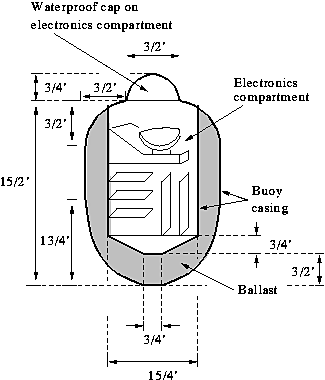Math 106--Calculus II: Project 2, Fall 1999
Floating merrily in the waves.....
by Gavin LaRose
(glarose@umich.edu),
Nebraska Wesleyan University, October 1999
©1999 Gavin LaRose (glarose@umich.edu)
permission granted to use and distribute free in an academic setting.
-
- PostScript
version of project
Hocklead-Tarmin, Inc.
15000 Dalame Dr.
Verden, DO 28802-0540
1 October 1999
Sophisticated Technical Contractors (STC), Inc.
Suite 1, Strawmarket Business Plaza
Lonlinc, SK 04685
Dear STC:
 As you know, we are here at Hocklead-Tarmin a leader in aerospace and
electronics contracting for the military. Concerned with the
inconsistency of this line of contracting (there are, after all, only
so many wars that one can start), we are branching out into other
areas of high-technology manufacturing. The most recent contract we
are pursuing has to do with the construction of a new scientific buoy
for the coast guard. This is to be moored in the open ocean, and
contains a number of rugged electronics pieces that are to continually
monitor the environment in which the buoy is located.
As you know, we are here at Hocklead-Tarmin a leader in aerospace and
electronics contracting for the military. Concerned with the
inconsistency of this line of contracting (there are, after all, only
so many wars that one can start), we are branching out into other
areas of high-technology manufacturing. The most recent contract we
are pursuing has to do with the construction of a new scientific buoy
for the coast guard. This is to be moored in the open ocean, and
contains a number of rugged electronics pieces that are to continually
monitor the environment in which the buoy is located.
A diagram of the buoy is shown to the right. The buoy casing is in
all cases (1/4)'' steel plate (density 486 lb/ft3), and the
ballast is an insulating padding with fairly low density
(21 lb/ft3). The electronics are quite light, but packed
differently at the top and the bottom so that the density
at the bottom is approximately 5 lb/ft3 and at the top only
1 lb/ft3. The cap on the electronics compartment is empty.
The buoy is designed so that the electronics compartment cap is
approximately hemispherical, and the upper 3/2' of the buoy is
similarly the upper quarter of a torus. The lower 13/4' of the buoy
is parabolic, with the exception of a flat circular section of 3/4'
diameter at its very bottom.
While we have been assured by our engineers that the configuration
that we show here will work impeccably, their area of expertise is in
aeronautics and we are looking to you for a second opinion. We need
to know how low in the water the buoy will float. It is probably
relevant that the buoy is to be anchored to the ocean floor by a steel
cable of diameter approximately 1/2'' and, because of its braided
nature, density approximately 1/8 that of solid steel. We
expect that the buoy will be anchored in water approximately 6,000 ft
deep.
We look forward to receiving your final report on this problem
on or before the 27th of October. We have arranged with a
local expert in all things mathematical, the estimable Dr. P. Gavin
LaRose, to serve as a contact with you should you find that you have
questions in its completion. Please note that you must contact
him by the 14th of October with your initial appraisal of the problem
and the manner in which it should be resolved. Failure to meet this
deadline will be cause for a significant penalty in your payment.
Yours sincerely,
O.W.R. Eit III
CEO, Hocklead-Tarmin, Inc.
owre3:glr
Gavin's Calc II Project 2, Fall 1999
Last Modified: Tue Oct 5 00:03:29 CDT 1999
Comments to
glarose@umich.edu
 As you know, we are here at Hocklead-Tarmin a leader in aerospace and
electronics contracting for the military. Concerned with the
inconsistency of this line of contracting (there are, after all, only
so many wars that one can start), we are branching out into other
areas of high-technology manufacturing. The most recent contract we
are pursuing has to do with the construction of a new scientific buoy
for the coast guard. This is to be moored in the open ocean, and
contains a number of rugged electronics pieces that are to continually
monitor the environment in which the buoy is located.
As you know, we are here at Hocklead-Tarmin a leader in aerospace and
electronics contracting for the military. Concerned with the
inconsistency of this line of contracting (there are, after all, only
so many wars that one can start), we are branching out into other
areas of high-technology manufacturing. The most recent contract we
are pursuing has to do with the construction of a new scientific buoy
for the coast guard. This is to be moored in the open ocean, and
contains a number of rugged electronics pieces that are to continually
monitor the environment in which the buoy is located.